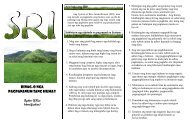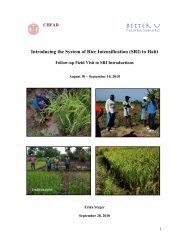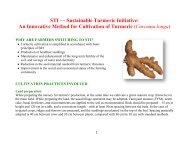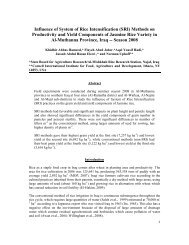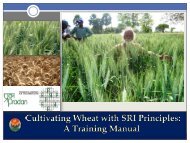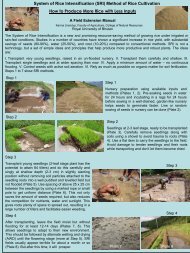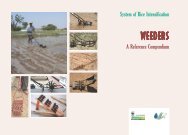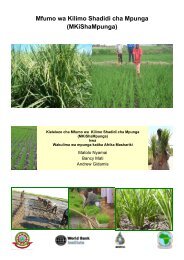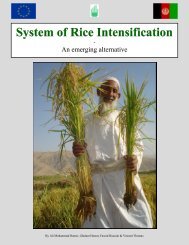EFFECT OF THE SYSTEM OF RICE INTENSIFICATION (SRI) ON ...
EFFECT OF THE SYSTEM OF RICE INTENSIFICATION (SRI) ON ...
EFFECT OF THE SYSTEM OF RICE INTENSIFICATION (SRI) ON ...
Create successful ePaper yourself
Turn your PDF publications into a flip-book with our unique Google optimized e-Paper software.
households were in average able to collect 1.817 kg of natural fertilizers per year 9 . Table 8<br />
illustrates how farmers split their compost and natural fertilizers between seedbed preparation, rice<br />
fields and vegetable productions.<br />
Table 8. Farmers’ use of compost and natural fertilizers for seedbeds, rice fields and vegetable<br />
production. Numbers are given in percentages of total compost and natural fertilizer production<br />
respectively. Derived from CEDAC (2008a).<br />
Seedbed Rice fields Vegetable production (dry season)<br />
Compost 38% 57% 3%<br />
Natural fertilizers 51% 44% 4%<br />
If in average one household is able to produce/save/collect 1.817 kg of natural fertilizers and use<br />
44% for rice fields then 805 kg will in average be available to use for the rice fields. With the given<br />
application rate of green manure of 1.90 kg per m 2 , a household will then be able to grow an area of<br />
423,65 m 2 with such applications of GM.<br />
The situation will be similar if the natural fertilizers are changed with the production and<br />
application of compost. One family can approximately produce 2550 kg year -1 of compost and if<br />
they use 58% of this amount for the rice field they will have 1475 kg available for their rice fields.<br />
With an average application rate of compost of 0.33 kg per m 2 their amount of compost will cover<br />
an area of 4472 m 2 .<br />
A gap in year 2009’s production<br />
It is assumed that the farmers are able to produce the app. same amount of compost every year.<br />
Average fields next year are, as mentioned before above, in average 3676 m 2 . Farmers relying on<br />
compost will need to produce 1213 kg of compost to meet the needs of next year’s area of 3676 m 2<br />
if they still rely on the same application rate of 0.33 kg compost m -2 . This is however not a problem<br />
as the farmers with compost are able to produce 4472 kg of compost only for rice fields<br />
disregarding the two other sectors: seedbed and vegetable production but on the other side is the<br />
application rate very low compared to other studies (see table 6) and could thus be increased.<br />
Farmers who rely on natural fertilizers will have to find 6985 kg to be able to grow <strong>SRI</strong> for the 2009<br />
season with an application rate of 1.9 kg m -2 which is an additional amount of 6180 kg and it will<br />
therefore be difficult for farmers to reach. The application rate of 1.9 kg m -2 is however also very<br />
9 Natural fertilizers comprise plant residues, green manure and leafy manures such as Neem, Sesbania, Leucaena etc.<br />
61



